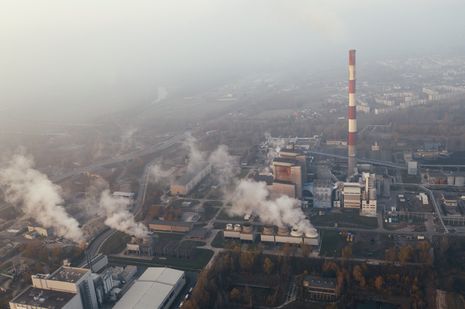Putting a price on CO2
Can carbon trading help solve climate change? Affan Iqbal explains how carbon markets work and where they still fall short

The Earth and its atmosphere form a closed environment in which the total amount of carbon remains constant over time. Human activities, amongst other factors, change how much carbon is in the atmosphere versus how much is stored in the Earth. Every time carbon is released into the atmosphere as CO2, where it’s able to contribute to global warming, there is a direct negative effect on someone, somewhere. For example, global warming has been shown to increase the likelihood of extreme weather events, contribute to ocean acidification, lead to increased food insecurity, increase disease burden in already struggling healthcare systems, and adversely impact childhood development .
One of the ways to mitigate the harmful effects of climate change is to transform the business landscape into one which appropriately incentivises the reduction of carbon emissions while penalising those that don’t contribute their fair share. There is an opportunity here to make use of what the market does best: respond with ingenuity and innovation to evolving situations and consumer demand.
Applying a direct carbon price to CO2-generating activities ensures the price of CO2 consumption is paid by those benefiting from it. It would also prevent the negative effects of climate change being shouldered by developing countries who have generally not been the beneficiaries of historic carbon consumption. They are, however, most likely to face the harshest consequences of climate change due to factors including geography, limited climate change mitigation ability, and vulnerable food sources.
“There is an opportunity here to make use of what the market does best: respond with ingenuity and innovation”
But does carbon pricing work? Data suggests it certainly does. Carbon pricing can reduce emissions while maintaining or even raising economic productivity. There are multiple ways of pricing, and one which provides significant flexibility is the cap-and-trade model. Under this model, businesses can trade portions of their annual emissions allowances with each other, just like any other commodity. A yearly reduction of annual allowances, corresponding to a reduction of total allowed emissions, encourages businesses to reduce their carbon emissions and invest in green alternatives.
After Brexit, the UK now has its own carbon emissions trading system (UK ETS), adapted from the EU’s carbon emissions trading system (EU ETS). The UK system has additional protection in the form of a minimum carbon price, referred to as a “carbon floor” to ensure price fluctuations don’t accidentally incentivise non-green activity. The UK ETS also has a smaller yearly emissions cap compared to the EU ETS. It should be noted, however, that both UK and EU ETS only cover energy-intensive sectors (which amount to 45% of their total emissions). This means that a direct carbon price is not currently applied to the majority of carbon emitting activities.
Beyond the compulsory carbon market, the voluntary carbon market provides businesses with a “verifiable” way of showing their commitment to emissions reductions. In the voluntary carbon market, businesses can purchase carbon credits that are “generated” through verified projects that reduce CO2 emissions. The amount of carbon credits generated by a project, and therefore available to purchase, depends on a verifiable and independent assessment of the amount of carbon emissions that are avoided or reversed. Examples of such projects include solar PV plants which remove a local community’s reliance on fossil fuels and biodiversity projects such as peatland restoration or tree-planting.
While the voluntary carbon market has the potential to reduce emissions, uptake has been limited in the West thus far. Instead, a growing number of companies are curating their marketing and communication strategies to signal a commitment to reducing emissions, leading to concerns of “greenwashing”. This is where some companies use misleading advertising and public messaging to portray themselves in a more environmentally friendly light than they actually are. This is problematic on two fronts, as it allows unsustainable activities to continue unchallenged and also lulls consumers into a false sense of complacency. The voluntary carbon market may solve this issue by providing verifiability to businesses’ claims of commitment to climate change.
From a strategic point of view, carbon trading forms part of an arsenal of carbon pricing mechanisms which includes direct carbon taxes, emission regulations and emission standards. This will also necessarily require measures such as a country-of-origin tax which would aim to ensure no “carbon leakage” occurs as the result of carbon trading. Carbon leakage is the phenomenon of supply chains moving to other territories where carbon pricing mechanisms are less well-developed. To minimise loopholes being exploited, global cooperation will be necessary to devise comprehensive policy frameworks. Luckily, there is a strong history of global cooperation in both economic and health policy. Therefore, while the climate challenge is unprecedented, there are cooperation models available which will enable us to tackle this problem together.
We also need to remind ourselves of the importance of thinking globally. Emissions anywhere around the world are problematic because climate change, much like Covid, does not respect borders. More broadly, the aim of carbon pricing isn’t to penalise businesses, but to create an environment wherein they can contribute to a low carbon future. As it stands, however, there is a significant gap between carbon trading’s potential positive impact and its current demonstrable reduction in emissions. Policymakers do not offer effective incentives – or consequences – to ensure that businesses contribute positively to the fight against climate change. Perhaps the pollution in the atmosphere is stopping them from being able to see and aim for the stars.
 Comment / Plastic pubs: the problem with Cambridge alehouses 5 January 2026
Comment / Plastic pubs: the problem with Cambridge alehouses 5 January 2026 News / Cambridge businesses concerned infrastructure delays will hurt growth5 January 2026
News / Cambridge businesses concerned infrastructure delays will hurt growth5 January 2026 News / New movement ‘Cambridge is Chopped’ launched to fight against hate crime7 January 2026
News / New movement ‘Cambridge is Chopped’ launched to fight against hate crime7 January 2026 News / AstraZeneca sues for £32 million over faulty construction at Cambridge Campus31 December 2025
News / AstraZeneca sues for £32 million over faulty construction at Cambridge Campus31 December 2025 Interviews / You don’t need to peak at Cambridge, says Robin Harding31 December 2025
Interviews / You don’t need to peak at Cambridge, says Robin Harding31 December 2025










